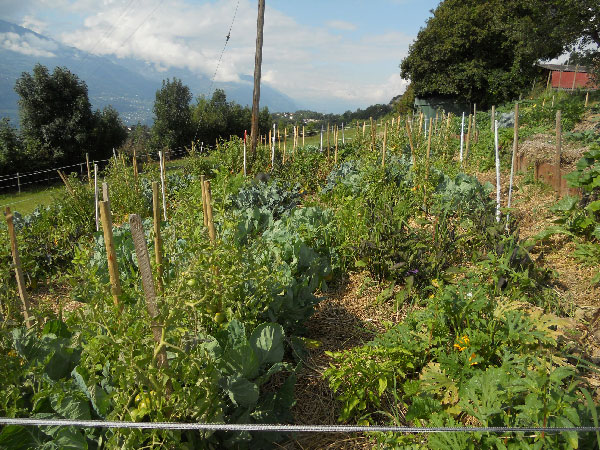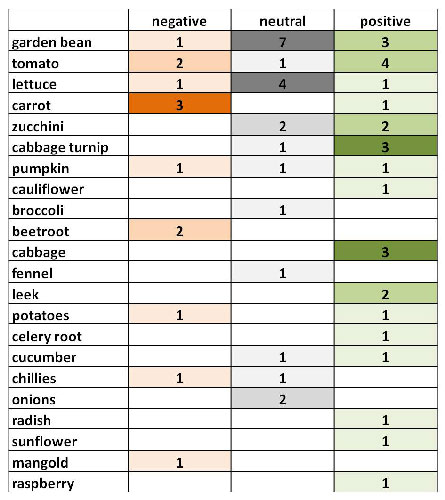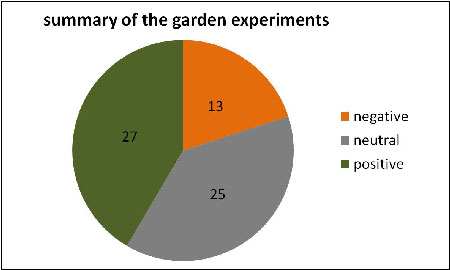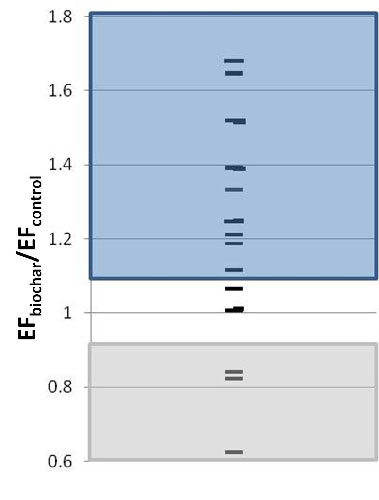Hobby Gardeners' Experiments on Biochar: Preliminary Evaluation
by Claudio Niggli & Hans-Peter Schmidt
Between May and June 2010 the first 180 gardeners from various regions of Switzerland received 10 kg of biochar and underlying instructions for carrying out the experiment. The characterized biochar is a product of the pyrolysis reactor of Swiss Biochar in Lausanne. By allowing the participants to select the experimental crops for themselves, it was possible to obtain a wide range of different crops and their corresponding response to biochar substrate. The participants were instructed to weigh the harvest from the biochar area of 10 m2 biochar as well as from the control area, without any biochar. Whenever possible, they were supposed to weigh the non-harvested biomass, such as leaves and shoots, and conduct a taste evaluation of fruits and vegetables.

Results
Unfortunately, it was not possible to supply the biochar until it was relatively late into the season. Some participants had already cultivated the beds, and as a result, out of the 180 participants only about 100 were able to carry on as planned during the growth period in the first year's round of experiments. By mid-November, out of the 82 responses that were received, only 65 experiments were suitable for statistical analysis.
After subjecting all the 82 experiments in a meta-analysis, the results showed a heterogenous and often contradictory picture. Out of the 65 experiments evaluated from 21 different cultures, 27 positive, 25 neutral and 13 negative trends in relation to the use of biochar were obtained. A harvest which weighed more than 10% of the control was assessed positive. Correspondingly, a harvest of less than 10% less was given a negative rating. Any result in between was considered as neutral (Fig. 1).

Certain tendencies could be identified by a sufficient number of trials obtained in the experiments. Beans showed neutral to positive responses to biochar. Tomatoes were apparently relatively sensitive (rarely neutral results) and responded more positively. Lettuce behaved also relatively neutral. Zucchini showed a tendency to an increased crop production. It is particularly striking that, no negative reactions were detected in any of the nine trials in the cabbage family (broccoli, cauliflower, cabbage turnip, cabbage); six showed a positive reaction. In the remaining cultures, the number of trials was too small to detect any tendency (Fig. 2).

Increased energy efficiency of plants
The resulting lop was measured in certain fruiting or flower vegetables (beans, tomatoes, broccolis, pumpkins, zucchinis, cauliflowers). A relatively meaningful value is the ratio of the harvest to the remaining above-ground biomass (leaf and shoot). This ratio is referred to hereafter as efficiency factor (EF). For example, if a tomato plant produces 1200g of tomatoes and after the harvest 800g of its leafy shoots are left, the resulting EF will be 1.5. The greater this factor is, the less biomass is needed for fruit production signifying a more efficient plant production process. Comparing the EF of plants from the biochar and the control surface, only three out of 19 trials (Fig. 3) resulted in approximately equal EF. Thirteen trials showed the efficiency of biochar plants was greater (blue highlighted area). In three trials, the efficiency of the control plants was less (gray shaded area).
Although 19 non-standardized tests are far too small to draw statistically reliable conclusions, this figure does show a very interesting effect of biochar, worthy of examination. If these results are confirmed, they will suggest that the symbiosis of plants with soil-borne microorganisms induces the absorption of more complex, energy-rich nutrients.

Interpretation of results
Biochar is a biologically sustainable soil conditioner and not a panacea, enabling the tomato plants produce twice as much harvest in a short period of time. At the best, chemical products, are able to achieve such amazing results while accompanied by well-known side effects. Biochar is not a fertilizer, but a skeletal framework, a habitat and a reservoir for soil microorganisms, minerals and water. It encourages soil life and influences the interaction of diverse functional groups of microorganisms, which in turn enter into symbiosis with the plant roots. Dynamic bindings, releases and transformations of inorganic and organic molecular groups take place on the highly porous surfaces of coal, which can reach up to 400 m2 / g, while having a large influence on soil nutrient dynamics .
In summary, a change in the soil environment occurs by incorporating biochar resulting in a biologically more efficient energy and material use. However, it takes time for the change in the soil environment to reach a new equilibrium state. At least in more humus-rich alkaline soils, useful results can be detected only gradually over several years.
Biological time
Biochar remaining in the soil as habitat for microorganisms for a few thousand years, does not get fully activated after only one or two months and is not organically bound into the soil food web. First, the coal particles have to wander through worm intestines in an innumerable number of times and be colonized by bacteria and fungal hyphae and then absorb minerals and humic substances. A certain effect can be seen right from the beginning but the new soil equilibrium form will ultimately depends on many factors and is difficult to predict.
Some researchers claim that the actual soil-forming effectiveness of biochar emerges recognizably only after several decades. However, we believe that the significant effect of biochar on the soil equilibrium can already be observed earlier. Our longest trials in the vineyard have shown that differences in the variants become increasingly manifested each year even though the measurable effects on the grapes can be demonstrated basically from the second year onwards. Even if the presented preliminary results may at first glance seem a bit disappointing, it could turn out to be quite beneficial as they direct our attention back to the very foundations of soil microbiology.
Variations in environmental factors
One of the practical implications of the use of biochar is the resulting increase in the soil's water holding capacity. However, water stress plays a relatively minor role in middle European gardens as these gardens are sufficiently watered. The effect of biochar on plant growth is lower in humus- and nutrient-rich soils such as those in organic gardening in general. Although biochar promotes particularly humus formation and nutrient dynamics of soils, its application could possibly be spared in soils with adequate humus content (depending on the clay content, from 3 – 6% and above). Even though biochar promotes and accelerates the build-up of humus, the decisive factor for a healthy plant growth is not the biochar, but the humus itself.
A bigger and usually more visible role of biochar can be seen in the change of the soil pH. The biochar we supplied had a basic pH (= 9.1). If such a coal is placed in an acidic soil, the pH of the soil will increase resulting in a significantly measurable impact on the microbial communities and nutrient uptake capacity. Plants that prefer a more acidic environment or are used to such will be disadvantaged (blueberries, lupine). On the contrary, those that prefer an alkaline environment will react very positively.
Difficulties of evaluating
One of the characteristics in such a huge experiment done by the people is that numerous factors cannot be standardized. Each garden has varying soil properties. Humus and clay content vary. The pH varies. The microbial environment of up to 5 billion microorganisms in a handful of soil varies. The maintenance of water supply varies. In our experience, compost quality also varies. The climate is on a large and a smaller scale, more or less, variable. Even the plant varieties of a crop are not uniform. Just think of all the different varieties of tomatoes such as Rose of Berne, oxheart, amber fire, San Marzano, etc.
The interactions between the compost, soil, biochar and microbial environment are crucial for the plant growth. Since it is unrealistic to analyse the soil, compost, climate and plant species individually in such an enormous experiment conducted by the people, we must find and evaluate the suitable criteria to determine the qualitative changes of soil, crop and yield aside from measuring just the yield and biomass.
The first stage of the meta-analysis shows that biochar does not have a direct positive effect on harvest in all circumstances. The obvious assumption that plants respond differently depending on the family, type and variety makes it more difficult to evaluate and, at the same time, more interesting.
It’s not the increase in harvest by 10% or 20% that is of highest relevance to the use of biochar in gardens, but whether the vegetables have a more intensive taste, or more active plant substances, or whether they stay fresh longer, or whether the entire soil is more active and stores more carbon. In order to include such qualitative characteristics for statistical evaluation, protocols must be revised until next season.
Prospects for next year's experiment
Next year, another 320 gardeners will be supplied with characterized biochar for the continuation of the large-scale experiment. The 180 participants who have already begun this year will continue the experiments without nutrient addition. The experiment will go on for at least three years. We are fortunate to perform a large-scale experiment of this nature despite suboptimal standardized conditions.
To benefit even more significantly from the results and to be able to include the influence of various soil as well as pedoclimatic and human factors, we announced an invitation for a master's thesis at the University of Zurich. The student involved will not just be requesting results, he/she will be present in the gardens of the many participants to determine him-/herself the specific local conditions. Separate soil, leaf and fruit analyses will complement the data collection.
The significance of the overall experiment will be further increased by recommending a shorter list of crops. The experimental protocols will be made easier to increase the motivation of the gardeners and improve the comparability of results.
As wine-growers, ecologists and climate farmers, we have chosen a profession that appears to us as the best of all possible professions. It is a wonderful experience to share this passion with 500 gardeners and to feel that we try to head together on the same Noah's Ark to the Garden of Eden. With this, we thank all participants and look forward to further cooperation.

F. Peter
2010-11-28 10:00
Leider haben Sie nur Aussagen über das Gewicht der Ernte
gemacht. Das macht die Kunstdünger-Industrie auch so.
Was ist mit der Pflanzengesundheit ?
Wie ist die Lagefähigkeit (Wer hat an Lichtmess noch etwas aus dem eigenen Garten)?
Gibt es Geschmacksveränderungen?
Hat die Anzahl der Regenwürmer im Boden zugenommen?
hps
2010-11-28 11:24
Mit der Forderung nach der Erherbung qualitativer Resultate haben Sie vollkommen recht. Um verstärkt eben solche Daten auswerten zu können, wurde die in Kürze beginnende Masterarbeit ausgeschrieben. Um die Vergleichbarkeit qualitativer Daten (und damit die statistische Auswertung) gewährleisten zu können, braucht es rigide Kriterien. Schnell würde das Versuchsprotokoll noch viel komplizierter, was viele der 500 nebenberuflichen Versuchsteilnehmern schnell abschrecken würde. Im Versuchsprotokoll gibt es übrigens die Fragen nach Geschmacksveränderungen, Gesundheitszustand der Pflanzen und sonstige Bemerkungen, doch nur wenige Teilnehmer haben dies ausgefüllt, so dass bisher keine Auswertung der qualitativen Resultate möglich war.
Wir werden nächstes Jahr je eine Skala von 1 bis 10 für Gesundheitszutstand, Geschmack usw. aufstellen, was die Aufnahme und Erweiterung erleichtert. Die Lagerfähigkeit einzubeziehen ist ein ganz hervorragender Vorschlag, den wir mit Sicherheit aufgreifen. Besten Dank.
Jochen Binikowski
2010-12-13 11:38
Super Editorial! Das mit der Förderung der CO2-Verpressung war mir neu, überrascht mich aber nicht. Es geht bei den ganzen Klimaabkommen offenbar nicht um eine netto Reduzierung der CO2-Emissionen, sondern um zusätzliche Steuern und Abgaben, die in die Taschen der Bürokraten und Konzern-Großaktionäre fließen.
Das einzige Problem, was denen den Schlaf raubt: Wie verhindern wir, dass Kleinbauern und Kleinbetriebe einige Krumen von dem schönen Zertifikate-Kuchen abbekommen?
Mich würde daher brennend interessieren, was in dem Waldschutz-Abkommen "REED" wirklich drinsteht. Es wäre keine Überraschung wenn damit das Abholzen der Urwälder zugunsten von Ölpalmen- und Gensoja Monokulturen noch stärker als bisher subventioniert werden.
Diesen etablierten Klima-Heinis glaube ich jedenfalls kein Wort mehr. Immerhin hat es hohen Unterhaltungswert, wenn diese Clowns sich über das abnehmende Klimabewustsein der Bevölkerung beklagen. In Anbetracht der über 100 Milliarden die den Bürgen jährlich für nichts aus den Taschen gezogen werden, weiß ich nicht ob man darüber lachen oder weinen soll.
James P. Feild
2011-04-17 01:00
Incredible job on this forum. I have been searching for a gardening site to follow. BTW, I found you searching with Yahoo.
Susanne Schweizer
2011-04-18 14:49
Ich habe Tibeterweizen - eine Seite mit, eine Seite ohne Biokohle gepflanzt.
Nun ist mir beim Jäten aufgefallen, dass der Boden auf beiden Seiten! viel lockerer ist, wie normal in unserem Garten. Scheinbar haben die Bodenlebewesen die Biokohle auf alle Seiten hin verteilt. Bin dann auf die Ernte gespannt, ob ein Unterschied sein wird.
Peter Sommerer
2011-05-01 17:30
Ich lese seit geraumer Zeit mit Hochspannung alles rund um Terra Preta und Holzkohleeinsatz im Garten. Finde eure Erfahrungsberichte und diese alte Technologie super. Habe vor in unserem Selbstversorger-Garten dieses nachhaltige Prinzip auch umzusetzen. Nur weiter so, bin auf eure Berichte gespannt und werde bei Zeit meine Erfahrungen auch hier einstellen.
Lilly
2015-03-07 18:25
Sehr schöner Beitrag zum Thema Pflanzenkohleversuche.
Ich habe hier vielleicht noch ergänzend einen Beitrag zum Thema Optimale Boden PH-Werte für Pflanzen. Hoffe das ich mit diesem Artikel Deinen Lesern noch ein paar Infos zu dem Thema <a href="http://www.mein-pflanzenblog.de/2015/02/optimale-boden-ph-werte-fuer-pflanzen/" rel="nofollow">Boden PH-Werte</a>geben kann.
Lieben Gruß
Lilly